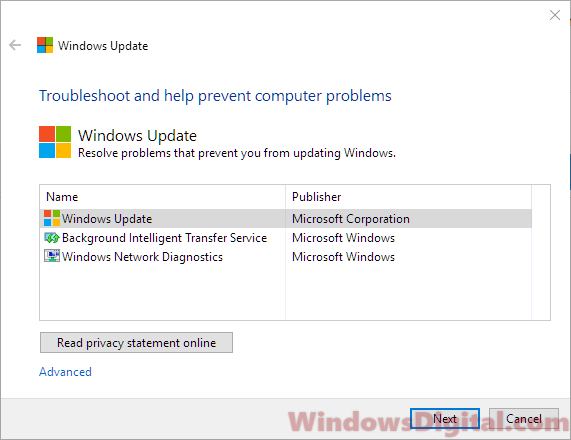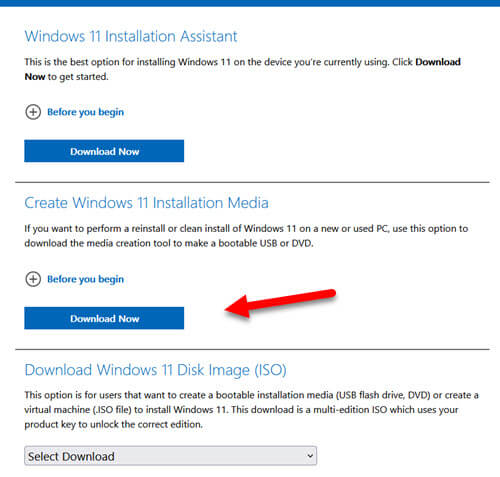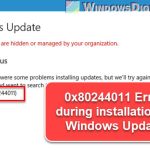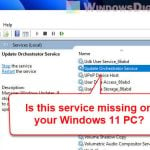If you have problems with Windows Update in Windows 11 or 10, you might try the Windows Update Troubleshooter to fix the issue. But sometimes, the troubleshooter tool itself doesn’t work, such as getting stuck at certain phase or process (e.g., endless “Detecting problems”). In this guide, we’ll show you some common issues with the Windows Update Troubleshooter and workarounds to fix them.
See also: Troubleshooting has been disabled by Group Policy Windows 11

Page Contents
Some common problems with the Windows Update Troubleshooter
The Windows Update Troubleshooter, although meant to fix problems, can also encounter issues itself, such as getting stuck at the “initializing diagnostic”, “resolving problems”, or “starting BITS service” process. Sometimes, it might also show an error message that tells you that the Windows service registration is missing or corrupted.
When you run the troubleshooter, it will suggest fixes that you can apply to resolve the issues it finds. However, there are cases where some errors may be identified but cannot be fixed by the Windows Update Troubleshooter alone, such as the 0x803c0103 and 0x80244022 Windows Update errors. In these cases, you will need to use repair tools such as DISM and SFC, which we’ll talk about later.
These issues can occur in different versions of Windows, including Windows 11 or Windows 10 Pro or Home edition, and Windows Server 2016 or 2012.
How to fix Windows Update Troubleshooter not working
Here are several ways to fix the Windows Update Troubleshooter if you’re experiencing issues with it in Windows 11 or Windows 10.
Download the Windows Update Troubleshooter
If the built-in Windows Update Troubleshooter isn’t working to resolve your issue or won’t even start, you can try downloading and using the Windows 10/11 Update Troubleshooter from Microsoft’s website.
- Download the Windows Update Troubleshooter for Windows 11/10 from here.
- Open the downloaded wudiag file with “Diagnostics Troubleshooting Wizard.” By default, all .diagcab files will run on “Diagnostics Troubleshooting Wizard.”

- In the “Windows Update Troubleshooting” window, click on the “Advanced” link.
- Make sure the “Apply repairs automatically” option is checked and enabled.

- Then, click on “Run as administrator” to allow the troubleshooter to run with admin privileges.
- In the troubleshooter, select “Windows Update.” Then, click “Next.”

- The Windows Update troubleshooter should start detecting problems and will return possible solutions if an error is found.
Download the latest servicing stack update (SSU)
If both the local and downloaded “Windows 10/11 Update Troubleshooter” do not work to fix your Windows Update issue, you can try to force-install the latest Servicing Stack Update (SSU). This is a common fix for when Windows Update couldn’t retrieve any updates or is always stuck at the “check for updates” status.
These issues could be due to corrupted updates in the past or missing system files, which cause Windows Update to lose track of what updates your PC needs. By installing the latest SSU, Windows Update will be able to recognize the version of the latest SSU so that it knows what updates your PC needs.
- Go to the Microsoft Update Catalog.
- In the search box, type “Servicing Stack Update” or the name of the update (KB#) and select the version that matches your operating system (e.g., Windows 10 or Windows 11, and 64-bit or 32-bit).

- Click on the “Download” button next to the update to start the download.
- Once the download is complete, double-click on the downloaded file to run it.
- Follow the on-screen instructions to install the latest SSU.
After installing the latest SSU, restart your computer and retry Windows Update again.
Run DISM and SFC to fix Windows Update Troubleshooter errors
“Deployment Imaging and Servicing Management (DISM)” is a built-in Windows repair tool that can automatically update files and correct servicing problems, including Windows Update Troubleshooter problems (such as the “0x803c0103” and “0x80244022” errors) for your Windows 10 or 11 image.
The “System File Checker (SFC)” is another built-in repair tool that can automatically scan for and repair corrupted and missing system files on your Windows PC.
To run these repair tools, go to the Start menu and type CMD. From the search result, right-click “Command Prompt” and select “Run as administrator.” In the command prompt, enter the following commands followed by an Enter key after each line of command:
Dism /Online /Cleanup-Image /RestoreHealth
sfc /scannow

The scans may take some time to complete. Enter the second command only after the first scanning is completed. When the repairs are completed, reboot your computer and try to run Windows Update again.
Besides these repair tools, you may want to run a full virus and malware scan using your antivirus software or Windows Defender. Malware or a virus could also be the cause of why your Windows Update couldn’t run or why the “Windows Update Troubleshooter” isn’t working in Windows 10/11. Run a full system scan to check for possible threats and remove them, then retry Windows Update again.
Run update using Windows 10 or 11 Media Creation Tool
If the Windows Update Troubleshooter fails to fix your problem, and you still can’t update your Windows, the last resolution would be to run an update using the Windows Media Creation Tool. This tool allows you to create installation media, such as a USB drive or DVD, to install or upgrade to Windows 10 or 11. The good thing about this tool is that you can also use it to do an in-place upgrade of your current Windows installation, which might potentially help fix the issue.
Note that you will need a working internet connection for this to work. Follow the steps below to proceed:
- Go to the here for Windows 10, or go to the here for Windows 11.
- Click on the “Download tool now” button to download the “Windows 10/11 Media Creation Tool.”

- Once the download is complete, open the tool and select the “Upgrade This PC Now” option.
- Click on the “Next” button to proceed.
- Select the option to “Keep Personal Files and Apps” and click on the “Install” button to begin the installation of the latest updates for Windows 10/11.
- Follow the on-screen instructions to complete the installation process.
- Wait for the installation to complete, and then restart your computer.
After the restart, your Windows OS should now have the latest updates and fixes. This process can, however, take some time (and patience) depending on your internet speed and the amount of updates that need to be installed.






